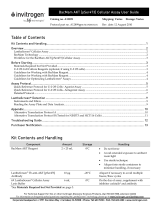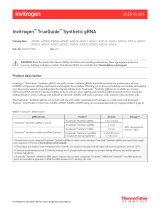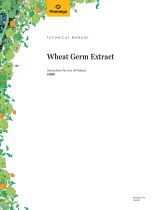Page is loading ...

Human Embryonic Stem Cells: Laboratory Manual
(Includes Invitrogen product information)
Michal Amit and Joseph Itskovitz-Eldor.
Department of Obstetrics and Gynecology, Rambam Medical Center and The Bruce
Rappaport Faculty of Medicine, Technion-Israel Institute of Technology
The use of the procedures contained herein is the subject of Patents, Patents
applications and other proprietary Intellectual Property owned by the authors and/or
by third parties. This document should not be considered an express or implied license
under any Intellectual Property rights.
Correspondence to Joseph Itskovitz-Eldor M.D., D.Sc., Department of Obstetrics and
Gynecology, Rambam Medical Center, P.O.B. 9602, Haifa 31096, Israel.
Tel.: +972-4-854-2536; Fax: +972-4-854-2503;
E-mail: Itskovitz@rambam.health.gov.il.
Copyright © 2002 Technion – Israeli Institute of Technology. All Rights reserved.
The information is copyrighted in Israel and worldwide by international treaty.
Revised; October 2002.
1

Copyright © 2002 Technion – Israeli Institute of Technology. All Rights reserved.
The information is copyrighted in Israel and worldwide by international treaty.
Revised; October 2002.
2
Content:
1. General:
1.1 Required equipment.
1.2 Required materials.
1.3 Gelatin coating of plates
1.4 Preparation of Pasteur pipettes
1.5 Preparation of Freezing solution.
2. Mouse embryonic fibroblasts (MEF):
2.1 MEF medium.
2.2 Derivation of MEF from pregnant mice.
2.3 MEF splitting.
2.4 MEF freezing.
2.5 MEF thawing.
2.6 Preparation of MEF-covered plates.
3. Human foreskin fibroblasts (HFF):
3.1 HFF medium.
3.2 Derivation of HFF from foreskins.
2.3 HFF splitting.
2.4 HFF freezing.
2.5 HFF thawing.
2.6 Preparation of HFF-covered plates.

Copyright © 2002 Technion – Israeli Institute of Technology. All Rights reserved.
The information is copyrighted in Israel and worldwide by international treaty.
Revised; October 2002.
3
4. Human embryonic stem cells (hES):
4.1 hES cell media:
4.1.1 Normal medium.
4.1.2 Serum- free medium.
4.2 hES cell splitting.
4.3 hES cell freezing.
4.4 hES cell thawing.
4.5 Formation of EBs.
4.6 Formation of teratomas.
4.7 Transfection.
4.8 Mini MACS sorting.
5. Abbreviations

Copyright © 2002 Technion – Israeli Institute of Technology. All Rights reserved.
The information is copyrighted in Israel and worldwide by international treaty.
Revised; October 2002.
4
1. General:
1.1 Required Equipment:
1. Class 2 Bio-Safety cabinets.
2. 37 °C Incubators with 5% CO2.
3. Inverted Phase -Contrast Microscope.
4. Table Centrifuge, preferably with an option for 4 °C.
5. Liquid Nitrogen storage container.
6. Autoclave and oven for sterilization.
7. 500ml autoclaveable glass bottle.
8. Culture dishes Nunc dishes recommended for hES cell culturing.
9. Pasteur pipettes.
10. Autoclaveable cylinders for Pasteur pipettes.
11. Petri dishes.
12. Watchmakers forceps (recomemended Dumont 5, Fine Scientific Tolls).
13. Sharp Iris scissors.
14. T75 culture flasks.
15. Nalgene freezing box. C.N.5100-0001.
16. 40μm MESH strainer
17. Glass slides

Copyright © 2002 Technion – Israeli Institute of Technology. All Rights reserved.
The information is copyrighted in Israel and worldwide by international treaty.
Revised; October 2002.
5
1.2 Required Materials:
1. Sterile water. Invitrogen cat. # 15230
2. Gelatin powder. Recommended type A, from porcine, Sigma G-1890.
3. Dulbecco’s Modified Eagle’s Medium (DMEM). Invitrogen cat #11960.
4. Fetal Bovine Serum defined (FBSd). Invitrogen cat. # 16141
5. Dimethyl sulfoxide (DMSO). Sigma D-2650.
6. Fetal Calf Serum (FCS). Invitrogen cat. # 16010
7. Penicillin-Streptomycin Invitrogen cat. # 15070
8. 70% ethanol.
9. PBS. Invitrogen cat. # 20012
10. Trypsin (TrypLE recommended) Invitrogen cat. # 12563
11. Mitomycin C. Sigma C.N. M-4287.
12. L-glutamine. Invitrogen cat. # 21051
13. Non essential amino acids. Invitrogen cat. # 11140
14. β-Mercaptoethanol. Invitrogen, cat. # 21985
15. KO-DMEM. Invitrogen cat. # 10829.
16. Serum replacement (SR). Invitrogen cat. # 10828.
17. basic Fibroblasts Growth Factor (bFGF). Invitrogen cat. # 13256.
18. Collagenase type IV. Invitrogen cat. # 17104
19. EDTA 0.5M Invitrogen cat. # 00-5500

Copyright © 2002 Technion – Israeli Institute of Technology. All Rights reserved.
The information is copyrighted in Israel and worldwide by international treaty.
Revised; October 2002.
6
1.3 0.1% Gelatin Coating of Plates
All plates should be covered with gelatin before the plating of cells.
1. Rinse an empty 500ml autoclaveable glass bottle with sterile water .
2. Autoclave bottle at 134 °C for 30 minutes.
3. Add 500mg of gelatin powder into cooled bottle (type A, from porcine, Sigma
G-1890).
4. Add 500ml of sterile water.
5. Autoclave at 121 °C for one hour. Store at room temperature.
6. Optional: filter the gelatin through 22 μM filter.
7. Cover plating dish according to the following table:
Plate/ dish Volume of gelatin per well
4 wells 0.5 ml
6 wells 2 ml
35 mm 2 ml
10 c2 m 10 ml
8. Leave at room temperature or in incubator for at least two hours.
Note:
It is highly recommended to prepare gelatin-covered- plates 24 hour before use.
Any high quality sterile water may be used.

Copyright © 2002 Technion – Israeli Institute of Technology. All Rights reserved.
The information is copyrighted in Israel and worldwide by international treaty.
Revised; October 2002.
7
1.4 Preparation of Pasteur Pipettes
The pasture pipettes are used or the daily medium change.
1. Insert pipettes into autoclaveable cylinders.
2. Place in oven for 4 hours at 180 °C.
Note:
We do not recommend the use of autoclave for this procedure as water residue may
cause contamination.

Copyright © 2002 Technion – Israeli Institute of Technology. All Rights reserved.
The information is copyrighted in Israel and worldwide by international treaty.
Revised; October 2002.
8
1.5 Preparation of Freezing Medium
The following freezing solution is used for hES cells, MEF and HFF.
Final concentrations:
60% Dulbecco’s Modified Eagle’s Medium (DMEM) Invitrogen cat #11960
20% Dimethyl sulfoxide (DMSO)
20% Fetal Bovine Serum defined (FBSd) Invitrogen cat. # 16141
Preparation:
1. Pour all materials into a 22- m filter, DMSO last.
2. Filter.
3. Store at 2-8 °C.
Note:
The use of different serum reduces the percentage of recovered cells.
May be used within two weeks of preparation.

Copyright © 2002 Technion – Israeli Institute of Technology. All Rights reserved.
The information is copyrighted in Israel and worldwide by international treaty.
Revised; October 2002.
9
2. Mouse Embryonic Fibroblasts (MEF):
2.1 MEF medium:
This medium is used for culture MEF post thawing.
Final concentrations:
90% Dulbecco’s Modified Eagle’s Medium (DMEM) Invitrogen cat #11960.
10% Fetal Calf Serum (FCS) Invitrogen cat. # 16010
Preparation:
1. Pour materials into 22 μm filter unite and filter.
2. Store at 2-8 °C.
Note:
Fetal Bovine Serum defined (FBSd) Invitrogen cat. # 16141 or
newborn calf serum Fetal Calf Serum (FCS) Invitrogen cat. # 16010 is also suitable.
May be used within two weeks of preparation.

Copyright © 2002 Technion – Israeli Institute of Technology. All Rights reserved.
The information is copyrighted in Israel and worldwide by international treaty.
Revised; October 2002.
10
2.2 Derivation of MEF from pregnant mice:
Use MEF medium (see 2.1) with the addition of Penicillin-Streptomycin Invitrogen
cat. # 15070
Preparation:
1. Use of pregnant ICR mice on the 13-day of conception is recommended.
Sacrifice 1 female mouse by brief exposure to CO2 .
2. Wash abdomen with 70% ethanol and dissect the abdominal cavity to expose
the uterine horns.
Remove the uterine horns into 10 c2 m Petri dish, and wash three times with
PBS. Invitrogen cat. # 20012 (See Fig 1 A and B).
3. Using two pairs of watchmakers forceps (Dumont 5, Fine Scientific Tolls
recommended product redundant) open each uterine wall and release all
embryos carefully without touching the mouse's fur.
4. Wash retrieved embryos three times with PBS. Invitrogen cat. # 20012
see Fig 1 C).
5. Use the same tools,to dissect each embryo from the placenta and membranes,
and discard soft tissues as much as possible.
6. Transfer clean embryos into new Petri dish and mince thoroughly using sharp
Iris scissors. (see Fig 1 D).
7. Add six ml of Trypsin (TrypLE recommended) Invitrogen cat. # 12563
and incubate for at least 10 minutes.

Copyright © 2002 Technion – Israeli Institute of Technology. All Rights reserved.
The information is copyrighted in Israel and worldwide by international treaty.
Revised; October 2002.
11
8. Neutralize trypsin using at least 6 ml of MEF culture medium. Transfer the
MEF into conical tubes. Use MEF culture medium to wash the plate.
9. Divide evenly into T75 culture flasks. We recommend a ratio of three
embryos per flask.
10. Add 20 ml MEF culture medium.
11. Grow the MEF up to three days or until confluent culture. Change medium at
least once during culture (do not vacuum the lumps).
12. Freeze the resulting MEF (2.4).
Note:
Other types of mice may be used.
Although pregnant mice at days 12-14 of conception may be used, day 13 of
conception is recommended

Fig 1. Preparation of MEF. (A) Mice uterine horns. (B) Released embryos.
(C) Resultant mash after thorough mincing of the embryos.
Copyright © 2002 Technion – Israeli Institute of Technology. All Rights reserved.
The information is copyrighted in Israel and worldwide by international treaty.
Revised; October 2002.
12

Copyright © 2002 Technion – Israeli Institute of Technology. All Rights reserved.
The information is copyrighted in Israel and worldwide by international treaty.
Revised; October 2002.
13
2.3 MEF Splitting:
1. Add 2 ml of Trypsin (TrypLE recommended) Invitrogen cat. # 12563
and cover the entire culture-flask surface.
2. Incubate for 6 minutes.
3. Tap side of the flask to loosen the cells. Add 4 ml of culture medium (2.1) to
neutralize the trypsin.
4. Remove cell suspension into conical tube and centrifuge for five minutes at
2000 rpm.
5. Remove suspension, re-suspend in desired volume of culture medium (see 2.1)
and pipette in order to fracture the pellet.
6. Distribute cell suspension to desired number of culture flasks.
7. Add MEF culture medium to final volume of 10ml.

Copyright © 2002 Technion – Israeli Institute of Technology. All Rights reserved.
The information is copyrighted in Israel and worldwide by international treaty.
Revised; October 2002.
14
2.4 MEF Freezing:
1. Remove all lumps possible.
Add 2 ml of Trypsin (TrypLE recommended) Invitrogen cat. # 12563
2. and cover the entire culture-flask surface.
3. Incubate for 6 minutes.
4. Tap side of the flask to loosen the cells. Add 4 ml of culture medium (see 2.1)
to neutralize the trypsin.
5. Remove cell suspension into conical tube. Let remaining lumps sink and
remove cell suspension into clean conical tube.
6. Centrifuge for five minutes at 2000 rpm.
7. Remove suspension, re-suspend in desired volume of culture medium (see 2.1)
and pipette in order to fracture the pellet.
8. Drop by drop, add an equivalent volume of freezing medium (see 1.5) and mix
gently.
9. Place 1 ml into two-ml cryogenic vials (it is recommended to freeze four vials
from one confluent flask).
10. Freeze vials overnight at -70 °C in Nalgene freezing box.
11. Transfer vials into a liquid nitrogen container.
Notes:
Adding the freezing medium drop by drop is crucial for cell recovery.
We collect all resultant flasks from the same mice and mark them with a batch
number, due to variations between different batches.

Copyright © 2002 Technion – Israeli Institute of Technology. All Rights reserved.
The information is copyrighted in Israel and worldwide by international treaty.
Revised; October 2002.
15
2.5 MEF thawing:
1. Remove vial from liquid nitrogen and thaw briefly in a 37 °C water bath.
3. When a small pellet of frozen cell remains, clean the vial using 70% ethanol.
4. Pipette the contents of the vial once, and transfer the cells into conical tube.
5. Drop by drop add 2 ml of culture medium (see 2.1).
6. Centrifuge for 5 minutes at 2000 rpm.
7. Re-suspense the pellet in culture medium.
8. Remove cells suspension into culture flasks and add 10 ml of culture medium .
Notes:
Adding the medium drop by drop is crucial for cell recovery.
It is recommended to thaw one vial into a T75 culture flask. If the batch of MEF is
sluggish you may thaw two vials per flask.
Do not thaw more than four vials at once.

Copyright © 2002 Technion – Israeli Institute of Technology. All Rights reserved.
The information is copyrighted in Israel and worldwide by international treaty.
Revised; October 2002.
16
2.6 Preparation of MEF-covered plates
1. Add 8 ng/ml mitimycin C into culture flask and incubate for two hours.
2. Wash four times with PBS. Invitrogen cat. # 20012
3. Add 2 ml of Trypsin (TrypLE recommended) Invitrogen cat. # 12563
recommended and cover the entire culture-flask surface.
4. Incubate for 6 minutes.
5. Tap side of the flask to loosen the cells. Add 4 ml of culture medium (see 4.1)
to neutralize the trypsin.
6. Remove cell suspension into conical tube.
7. Centrifuge for five minutes at 2000 rpm.
8. Remove suspension, re-suspend in 10 ml of culture medium ( see 4.1) and
pipette in order to fracture the pellet.
9. Count cells and re-suspend in desired medium volume (see 4.1).
10. Add cell suspension into culture dishes. We recommend on 4x105 cells per
well in six-well plates.
11. Let set for at least two hours before plating hES cells.
Note:
MEF number can also be calculate as 3x10 4 cells per c2m.
Do not use KO-DMEM containing medium (4.1.2) for plating MEF.

Copyright © 2002 Technion – Israeli Institute of Technology. All Rights reserved.
The information is copyrighted in Israel and worldwide by international treaty.
Revised; October 2002.
17
3. Human Foreskin Fibroblasts (HFF):
3.1 HFF medium:
Final concentrations:
80% Dulbecco’s Modified Eagle’s Medium (DMEM) Invitrogen cat #11960.
20% Fetal Bovine Serum defined (FBSd). Invitrogen cat. # 16141
2 mM L-glutamine. Invitrogen cat. # 21051
1% Non essential amino acids. Invitrogen cat. # 11140
0.1% mM β−Mercaptoethanol Invitrogen, cat. # 21985
Preparation:
1. Pour all materials into 22 μm filter unite and filter.
2. Store at 2-8 °C.
Note:
If desired, human serum or SR may replace FBSd.
May be used within two weeks of preparation.

Copyright © 2002 Technion – Israeli Institute of Technology. All Rights reserved.
The information is copyrighted in Israel and worldwide by international treaty.
Revised; October 2002.
18
3.2 Derivation of HFF from Foreskins:
For HFF derivation we use HFF medium (see 3.1) with the addition of Penicillin-
Streptomycin . Invitrogen cat. # 15070
Preparation:
Place newborn human foreskins in PBS. Invitrogen cat. # 20012
1. supplemented with Penicillin-Streptomycin Invitrogen cat. # 15070 within 48
hours of circumcision .
2. Unfold foreskin and wash three times with PBS. Invitrogen cat. # 20012
3. Cut into small pieces using sharp Iris scissors ( approximately eight pieces per
foreskin).
4. Transfer clean pieces into a new Petri dish and mince thoroughly using sharp
Iris scissors.
Add six ml of Trypsin (TrypLE recommended) Invitrogen cat. # 12563 and incubate
for at least 30 minutes.
5. Neutralize the Trypsin (TrypLE recommended) Invitrogen cat. # 12563
using at least 6 ml of HFF culture medium (see 3.1). Transfer the HFF into
conical tubes. Use HFF culture medium to wash the plate.
6. Divide evenly into T25 culture flask at a recommended ratio of two pieces
per flask.
7. Add 6 ml HFF culture medium (see 3.1).
8. Grow the HFF until confluent culture. Change medium as needed (do not
vacuum the lumps).
9. Freeze the resulting HFF (see 3.4).

Copyright © 2002 Technion – Israeli Institute of Technology. All Rights reserved.
The information is copyrighted in Israel and worldwide by international treaty.
Revised; October 2002.
19
Note:
Culture flasks may be covered with gelatin (see 1.3).

Copyright © 2002 Technion – Israeli Institute of Technology. All Rights reserved.
The information is copyrighted in Israel and worldwide by international treaty.
Revised; October 2002.
20
3.3 HFF Splitting:
1. Add 2 ml of Trypsin (TrypLE recommended) Invitrogen cat. # 12563 and cover
the entire culture-flask surface.
2. Incubate for 6 minutes.
3. Tap side of the flask to loosen the cells. Add 4 ml of culture medium (see 3.1)
to neutralize the trypsin.
4. Remove cell suspension into conical tube and centrifuge for five minutes at
1500 rpm.
5. Remove suspension, re-suspend in culture medium (3.1) and pipette in order
to fracture the pellet.
6. Distribute cell suspension to desired number of culture flasks.
7. Add 6 ml of HFF culture medium (3.1).
/













